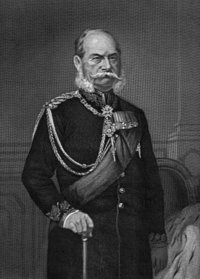Albrecht Graf von Roon
|
|
Graf_Roon_.jpg
Prussian Minister of War
Albrecht Theodor Graf Emil von Roon (30 April 1803 - 23 February 1879) was a Prussian soldier and politician.
He was born at Pleushagen, near Colberg, in Pomerania. His family was of Flemish origin, and was settled in Pomerania. His father, an officer of the Prussian army, died in poverty during the French occupation, and young von Roon was brought up, in a country ravaged in the War of Liberation and in straitened circumstances, by his maternal grandmother.
| Contents |
Education and publications
He entered the corps of cadets at Culm in 1816, from where in 1818 he proceeded to the military school at Berlin, and in January 1821 received a commission in the 14th (3rd Pomeranian) regiment quartered at Stargard in Pomerania. In 1824 he went through the three years higher course of study at the war school in Berlin, where he improved his general education. In 1826 he was transferred to the 15th regiment at Minden, but in the same year was appointed an instructor in the military cadet school at Berlin, where he devoted himself especially to the subject of military geography. He published in 1832 the well-known Principles of Physical, National and Political Geography, in three volumes (Grundluge der Erd-, Volker- und Staaten-Kunde), which gained him a great reputation, and of which over 40,000 copies were sold in a few years. This work was followed in 1834 by Elements of Geography (Anfangsgrunde der Erdkunde), in 1837 by Military Geography of Europe (Militärische Landerbeschreibung von Europa), and in 1839 by The Iberian Peninsula (Die Iberische Halbinsel).
Early military career
Meantime, in 1832, he rejoined his regiment, and was afterwards attached to the headquarters of General von Müffling's corps of observation at Krefeld, when he first became alive to the very inefficient state of the Prussian army. In 1833 he was appointed to the Topographical Bureau at Berlin, in 1835 he entered the General staff, and in the following year was promoted captain and became instructor and examiner in the military academy at Berlin. In 1842, after an illness of two years brought on by overwork, he was promoted to major and attached to the staff of the VII Corps, in which post he was again impressed with the inefficiency of the organization of the army, and occupied himself with schemes for its reform. Two years later, as tutor to Prince Frederick Charles, he attended him at Bonn University and in his European travels. In 1848 he was appointed chief of the staff of the VIII Corps at Koblenz. During the disturbances of that year he served under the Prince Wilhelm (afterwards German emperor) in the suppression of the insurrection at Baden, and distinguished himself by his energy and bravery, receiving the 3rd class of the order of the Red Eagle in recognition of his services. While attached to the Prince's staff at that time he broached to him the subject of his schemes of army reform. In 1850 came the revelation of defective organization and efficiency which led to the humiliating treaty of Olmütz. In the same year Roon was made a lieutenant-colonel, and in 1851 full colonel.
His army reform: the “System”
Promoted to be major-general in 1856 and lieutenant-general in 1859, Roon had held since 1850 several commands and had been employed on important missions. Prince William became regent in 1857, and in 1859 he appointed Roon a member of a commission to report on the reorganization of the army. Supported by Otto von Manteuffel and Helmuth von Moltke, Roon was able to get his plans seriously considered and generally adopted. His aim was to create an armed nation, to extend Scharnhorst's system and to adapt it to Prussia's altered circumstances. To attain this he proposed a universal three years' service, and a reserve (Landwehr) for the defence of the country when the army was actively engaged. During the Austro-Sardinian War he was charged with the mobilization of a division. At the end of 1859, though the junior lieutenant-general in the army, he succeeded Eduard von Bonin as war minister, and two years later the ministry of marine was also entrusted to him. His proposals of army reorganization met with strong opposition, and it was not until after long fighting against a hostile majority in the chambers that, with Otto von Bismarck's aid, he carried the day. Even the Danish campaign of 1864 did not wholly convince the country of the necessity of his measures, and it required the Austro-Prussian War of 1866 to convert obstinate opposition into enthusiastic support.
National hero
After that, Roon, from being the best-hated man in Prussia, became the most popular, and his reforms were ultimately copied throughout continental Europe. He was promoted general of infantry at the outbreak of the Austrian, was present at the decisive victory at Königgrätz, and received the Black Eagle at Nikolsburg on the road to Vienna. His system, adopted after 1866 by the whole North German Confederation, produced its result in the victorious Franco-Prussian War in 1870-71, throughout which Roon was in attendance on the German emperor. The fiftieth anniversary of his entrance into the army was celebrated at Versailles on January 19 1871, when the emperor expressed his gratitude for the great services he had rendered. He was created a graf (count), and in December 1871, having resigned the ministries of war and marine, he succeeded Bismarck as president of the Prussian ministry. Ill-health compelled him to resign in the following year. He was promoted to be field marshal on January 1 1873. He died at Berlin on the 23rd of February 1879.
Notes
| Preceded by: Eduard von Bonin | Prussian Minister of War 1859–1873 | Succeeded by: Georg von Kameke |
| Preceded by: Prince Bismarck | Prime Minister of Prussia 1873 | Succeeded by: Prince Bismarck Template:End boxde:Albrecht Graf von Roon no:Albrecht von Roon |

